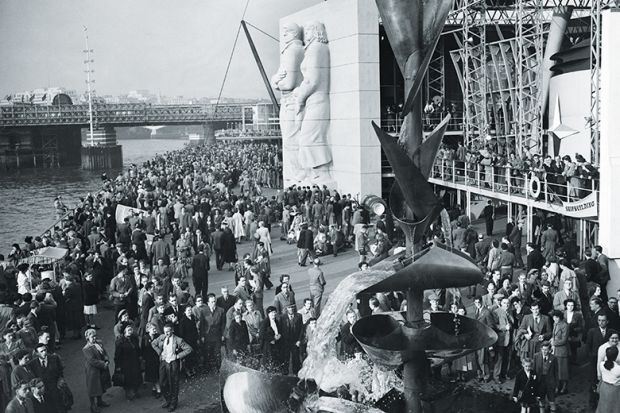“Monsters and dreams stalked London’s South Bank in 1951.” This first line of Lisa Mullen’s book is both compelling and disturbing – and it makes the well-known sights of the Festival of Britain usefully troubling. For the festival was, in her words, not simply a piece of patriotic celebration where “whimsical displays of moth-eaten eccentricity and colourful kitsch” bumped up against the icons of modernity and “technological utopianism”. Rather, those few acres beside the Thames were where the profound – and hitherto underexamined – strangeness of mid-century British culture was to be glimpsed.
It is a bold and counter-intuitive claim, but one that is theorised and developed over six absorbing chapters. It is also held together with a conceptual frame: Mullen contends that this strangeness was gothic. For she argues, mostly persuasively, that only the gothic as a mode can explain how the objects of modernity – from TV sets to prosthetic limbs, and from murals to missiles – could be so troubling. This was because their “uncanniness” came from being independent of their human creators and yet also enmeshed with the vulnerable human body. The use of the gothic to understand the period is not entirely new. Sara Wasson’s Urban Gothic of the Second World War (2010) offered a reading of some of the same texts. But Mullen is more ambitious in scope: tracing how the gothic, as a powerfully popular form, can explain the specific traumas encoded in works – but also how the gothic thus itself changes. Such a venture inevitably requires theoretical scaffolding: Mark Fisher is here to help critique Freud’s notion of the uncanny; and “Thing Theory” of the early 2000s gets another moment in the sun.
Mullen has vivid and telling details from the works of the time – such as Karel Reisz and Tony Richardson’s film Momma Don’t Allow (1956) and Elizabeth Bowen’s novels. But to create a thick description of culture, without any presumption of an aesthetic hierarchy, the book ranges beyond the “objects” of novels or paintings – and includes transient works such as The Masque of Hope (1948) and Barbara Jones’ fantastic exhibition Black Eyes and Lemonade (which formed part of the Festival of Britain).
Although her focus is on 1945-55, Mullen is astute enough to understand that the Second World War was not a watertight period of “war culture”, but rather one that intensified and connected that which came before and after. So William Sansom, the Blitz fireman and short-story writer, gets some well-deserved attention (although sadly only two of his stories are analysed), as do the cultural aftershocks from the Sutton Hoo excavations of 1939. The paperweight from the junk shop in George Orwell’s 1984 is here – both as a deceptive dream portal and as a smashed sign of pathos. It is, in Mullen’s words, “a mendacious magnifying lens”. Using the term “the mid-century” to think about the years 1935-55 is a hopefully less fragile critical optic. For it allows a plethora of superb writers and artists – from Rose Macaulay to Jaquetta Hawkes, or Prunella Clough to Ithell Colquhoun – to be understood in ways that are not defined solely by “a dialogue with declining modernism, or with later avant-garde experimentation”. Indeed, Edinburgh and Oxford University Presses both now have specific series on “the mid-century”; perhaps the year 1951 will become as talismanic as 1922 used to be for both students and critics.
Leo Mellor is Roma Gill fellow in English at Murray Edwards College, Cambridge.
Mid-Century Gothic: The Uncanny Objects of Modernity in British Literature and Culture after the Second World War
By Lisa Mullen
Manchester University Press
240pp, £80.00
ISBN 9781526132772
Published 1 March 2019
POSTSCRIPT:
Print headline: The monsters in the mod cons
Register to continue
Why register?
- Registration is free and only takes a moment
- Once registered, you can read 3 articles a month
- Sign up for our newsletter
Subscribe
Or subscribe for unlimited access to:
- Unlimited access to news, views, insights & reviews
- Digital editions
- Digital access to THE’s university and college rankings analysis
Already registered or a current subscriber?







